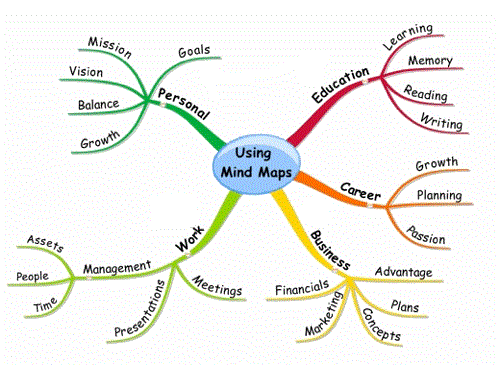Mind mapping is a very old technique which has been used for centuries for brainstorming, visual thinking and problem solving in all subject areas. Some of the earliest examples date back to the 3rd century where these techniques have been used by the famous Greek philosopher Aristotle.
A mind map is a powerful graphic technique which provides a universal key to unlock the potential of the brain. It harnesses the full range of cortical skills – word, image, number, logic, rhythm, colour and spatial awareness – in a single, uniquely powerful manner. In so doing, it gives you the freedom to roam the infinite expanses of your brain.
Mind mapping was further developed by Tony Buzan following his research into note-taking techniques in the late 1960s. Mind maps are a type of diagram used to visually display information in a relational way. Typically they start with a central idea, denoted by a word and/or image. Concepts and ideas associated with the central topic radiate out from the main topic on branches. Further associations can then be added to those branches and so on, so that the main topic remains central and the more remote details or associations end up at the edges of the map. By focusing on key ideas written down in your own words and looking for connections between them, you can map knowledge in a way that will help you to better understand and retain information. Mind maps can be very complex or fairly simple but the aim is the same ‘to structure, remember and show linkages between information and ideas both quickly and easily’.
Mind mapping was developed as an effective method for generating ideas by association. Because of the large amount of association involved, mind maps can be very creative, tending to generate new ideas and associations that have not been thought of before. Every item in a mind map is in effect, the center of another map.
A mind map consists of a central idea or concept — then around the central idea, you draw the 5 to 10 main ideas that relate to that word. You then take each of those child ideas and again draw the 5 to 10 main ideas that relate to each of those ideas. In this way an exponential number of related ideas can quickly be produced with virtually no mental effort. Here’s a quick overview of the steps in creating a mind map:
- Write the central topic in a circle in the center of a piece of paper. You may find it easier to place your page on the side, in landscape orientation, which is easier for drawing purposes.
- For each of the main points, draw arms out from the circle. Use lines, arrows, speech bubbles, branches and different colors as ways of showing the connection between the central topic and your ideas stemming from that focus.
- Write the key words of the main point along each or at the end.
- Draw smaller arms out from the main arms and write the sub-points that relate to each main point.
- Continue with smaller arms if you have other points or examples for the sub-points.
Mind maps are most valuable when the key objective is to develop a comprehensive understanding of all the key concepts involved in a subject area. Here are some golden rules of mind mapping technique:
- Objectivity: The various elements must be positioned as objectively as possible, without judgment, giving free rein to ideas and imagination.
- Representation: The ideas should be visually represented to facilitate the exchange and communication with other participants.
- No perfection: Do not try to create a perfect map at the first attempt. The map will be subsequently examined to ascertain whether all possible links are there, and to organize and classify all related elements.
The creative potential of a mind map is useful in brainstorming sessions. You only need to start with the basic problem as the center, and generate associations and ideas from it in order to arrive at a large number of different possible approaches. By presenting your thoughts and perceptions in a spatial manner and by using color and pictures, a better overview is gained and new connections can be made visible.
Another important application of mind map is in the field of project management. Because mind maps are visually orientated and allow for the gathering, management and sharing of a lot of information, they are ideally suited as a project management tool. A project manager can use a mind map to assign priorities, and determine which specific resources are needed for both individual task, and the overall project. Ideas can be assigned a task status, and the percentage completed can also be displayed. Relationships between actions can be established which makes managing resources much easier.
The advantages of mind mapping include its ‘‘free-form’’ and unconstrained structure. There are no limits on the ideas and links that can be made, and there is no necessity to retain an ideal structure or format. Mind mapping thus promotes creative thinking, and encourages ‘‘brainstorming’’. A disadvantage of mind mapping is that the types of links being made are limited to simple associations. Absence of clear links between ideas is a constraint. Mind maps have been said to be idiosyncratic in terms of their design, often hard for others to read; representing only hierarchical relationships (in radial form); inconsistent in terms of level of detail; and often too complex and missing the ‘‘big picture’’. Mind mapping is also limited in dealing with more complex relationships.
External Links:
- Mind Mapping – Tony Buzan
